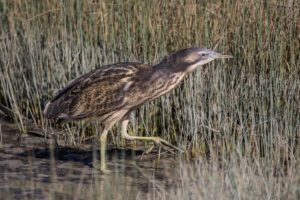 It’s been an exciting time for bird-lovers in the Tutukaka and Ngunguru area, as the Botaurus poiciloptilus, matuku or Australasian bittern makes itself known again.
It’s been an exciting time for bird-lovers in the Tutukaka and Ngunguru area, as the Botaurus poiciloptilus, matuku or Australasian bittern makes itself known again.
You may have noticed the bittern’s booming calls echoing across the local wetlands; or maybe you’ve seen slightly larger bird shapes than the average duck or heron moving through our swamplands: if so, then you may have unwittingly been exposed to the Australasian bittern. These birds are a beautiful mottled brown colour, ideally adapted to blend with their preferred nesting areas of raupo (bulrush).
We’re hoping that the bittern increase is also indicative of an uptake in the local frog population: wouldn’t that be fantastic? Either way, we’re very excited to welcome back our shy, wetland-dwelling feathered friends, and it’s inspired us to create a bittern fact sheet for those of you who – like us – love to know more about our local birdlife here on the Tutukaka coast in Northland.
Bitterns: our noisy polygamous neighbours
Yes, bitterns have more than one mate – at least in Europe. Researchers have confirmed that the male of the European species takes a number of female mates, contributing nothing to the nest-making nor the raising of the young, and becoming extremely aggressive towards encroaching males. We’re still unsure whether this polygamous behaviour is exhibited by the kiwi variety, but in either case, the male birds certainly make their presence known! The bittern call is both loud, deep and haunting: and each call is like a fingerprint, unique to it’s owner. These birds rely on the foghorn force of their call to let any other male birds in the area know exactly what they could be dealing with, should they decide to make a play for the territory.
Safety in stillness. Bitterns blend perfectly for protection
If you’re keen on spotting a bittern in the Ngunguru wetlands or Tutukaka area, then you may need a certain amount of patience. Bitterns are renowned for their ability to blend with their surroundings, looking for all the world like an old twig or a clump of reeds. They’re masters of their craft, swaying with the wind and angling their necks to mimic branches or grasses. Often, they can be indistinguishable from their surroundings until they feel safe enough to move freely: so be sure to bring your thermos, your blanket, and a good set of binoculars for easy viewing. While numbers were dropping drastically through the 80’s, 90’s and early 00’s, we have reason to believe that the local population may be on the rise again: it’s a great sign for our ecology, and a wonderful chance to see one of NZ’s loudest swamp-dwelling birds!
Eels, frogs, mice and chicks: what do bitterns eat?
Of course, the success of any birdlife also connotes the success of their menu: and in the case of a bittern, this means that we could be experiencing an increase in our local population of eels, our native swamp fishes, our invertebrates and our small bird chicks. Of course, it could also indicate an increase in mice or rats: but let’s hope for frogs, fishes and invertebrates! So far, it seems that our local population love to predate on the small fish that populate our wetland areas, but are also eating insects, spiders, lizards, freshwater crayfish and molluscs.
A population in decline – can you spot a bittern?
We’d love to know if you’ve seen or heard a bittern. These beautiful wetland-dwellers are notoriously secretive and hard to spot, which makes reliable data hard to come by. If you’ve seen or heard a bittern in your area, please alert your local Department of Conservation office. Every bird counts, so please: keep listening for those booming calls, and let’s preserve our wetlands!




 Join Tutukaka Land Care
Join Tutukaka Land Care